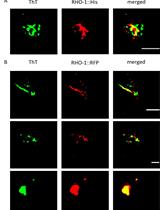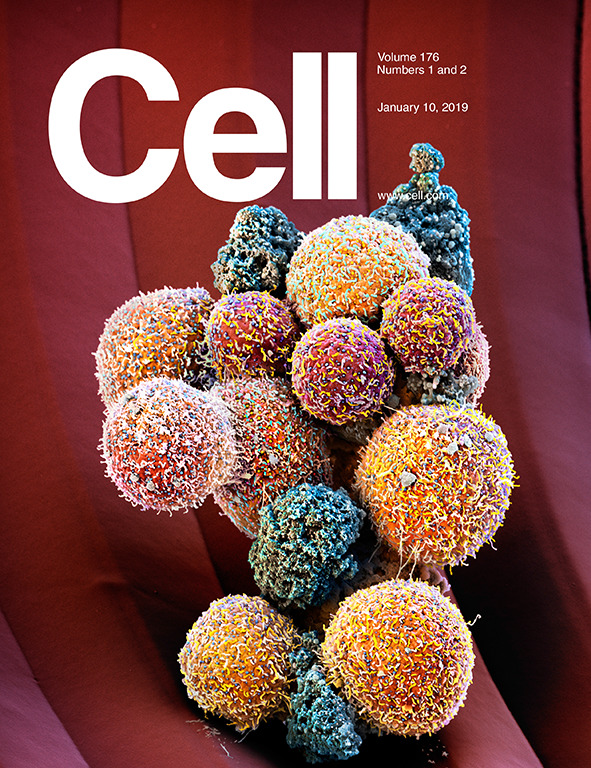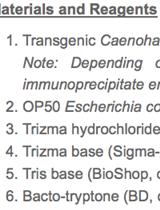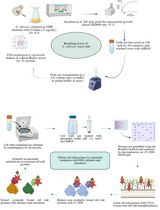- EN - English
- CN - 中文
Cell Type-specific mRNA Purification in Caenorhabditis elegans via Translating Ribosome Affinity Purification
秀丽隐杆线虫细胞特异性mRNA的核糖体亲和纯化
发布: 2019年08月05日第9卷第15期 DOI: 10.21769/BioProtoc.3328 浏览次数: 5195
评审: Anand Ramesh PatwardhanSaumik BasuAnonymous reviewer(s)

相关实验方案

TEM和SIM技术用于秀丽隐杆线虫His-和RFP标记淀粉样蛋白的分离和成像
Amberley D. Stephens [...] Gabriele S. Kaminski Schierle
2019年11月05日 4320 阅读
Abstract
Cell type-specific molecular profiling is widely used to gain new insights into the diverse cell types that make up complex biological tissues. Translating ribosome affinity purification (TRAP) is a method in which the cell type-specific expression of epitope-tagged ribosomal subunits allows one to purify actively translating mRNAs without the need for cell sorting or fixation. We adapted this method for use in C. elegans to identify novel transcripts in single cell types or to identify the effects of environmental changes on the transcriptomes of larger cohorts of cells. In this protocol, we describe methods to generate transgenic animals bearing tagged ribosomes in cells of interest, prepare these animals for immunoprecipitation, purify ribosome-mRNA complexes, and obtain purified mRNA for next-generation sequencing.
Keywords: RNA purification (RNA纯化)Background
With the advent of next-generation sequencing technologies, transcriptome profiling of defined cell populations and single cells has reached new heights of popularity. Many new techniques to isolate mRNA from select cells have arisen as a consequence. Translating Ribosome Affinity Purification (TRAP), or ribotagging, is a method to purify polysomal RNA from genetically-defined cell types (Heiman et al., 2008; Sanz et al., 2009; Heiman et al., 2014). In this method, epitope-tagged ribosomes are expressed in cells of interest, then tissue is extracted in the presence of cycloheximide, which stalls the ribosomes on the mRNAs that they are translating and thereby preserves a snapshot of translation. Tagged ribosomes are then affinity purified and the isolated RNA can be analyzed via quantitative PCR, microarrays, or RNA sequencing. This technique is advantageous because it does not require fixation or sorting of cells, has a high degree of sensitivity, and detects only the translated pool of mRNAs.
We recently adapted the TRAP methodology for use in the nematode Caenorhabditis elegans. We have used this method to identify novel transcripts that are enriched in the serotonergic neurosecretory motor (NSM) neuron (Rhoades et al., 2019) and to identify transcripts that vary with environmental changes in the entire nervous system (unpublished results). TRAP is particularly valuable in C. elegans because it is relatively easy to generate new transgenic lines for any cell type of interest, and because it can provide a snapshot of gene expression following an experimental manipulation. TRAP complements previous methods for neuron-specific mRNA isolation in larval and adult C. elegans, such as fluorescence-activated cell sorting (FACS) of dissociated cells (Spencer et al., 2014, Kaletsky et al., 2018) and affinity purification with epitope-tagged poly(A) binding protein (Roy et al., 2002, Takayama et al., 2010).
A TRAP protocol has previously been described in C. elegans (Gracida and Calarco, 2017). Our protocols share many similarities as both are derived from original protocols developed for mouse tissue and cell culture. Some key differences are the use of a distinct ribosomal subunit (tagged rpl-1 versus rpl-22 here) and epitope tag (GFP versus HA here). Both of these approaches have been successfully used in mammalian systems and appear to be sensitive and robust in C. elegans. The method that we describe here has successfully isolated mRNA from single C. elegans neuronal cell types (Rhoades et al., 2019).
Materials and Reagents
- 15 cm Petri dishes (Corning, catalog number: 351058)
- RNase-free pipette tips
- Glass slides (ThermoFisher, catalog number: 3011-002)
- 1.5 ml low-adhesion RNAse-free microcentrifuge tubes (USA Scientific, catalog number: 1415-2600)
- 50 ml conical centrifuge tubes (Corning, catalog number: 352098)
- 15 ml conical centrifuge tubes (Corning, catalog number: 352097)
- RNase-free 20 µl filter tips (Rainin, catalog number: RT-20F)
- RNase-free 200 µl filter tips (Rainin, catalog number: RT-200F)
- RNase-free 1,000 µl filter tips (Rainin, catalog number: RT-1000F)
- RNase-free disposable serological pipettes (Corning, catalog number: EF20361E)
- RNAse-free disposable pellet pestles with tubes (Thermo Fisher Scientific, catalog number: 12-141-368)
- Caenorhabditis elegans (100 young adult animals)
- rpl-22-3xHA plasmid (Addgene, catalog number: 122203)
- FseI and AscI restriction enzymes (New England Biolabs, catalog numbers: R0588, R0558)
- Liquid nitrogen
- 1,2-diheptanoyl-sn-glycero-3-phosphocholine (DHPC; Avanti, catalog number: 850306P)
- Dynabeads Protein G (Thermo Fisher Scientific, catalog number: 10004D)
- Monoclonal anti-HA antibody, purified, clone HA-7 (Sigma-Aldrich, catalog number: H3663-200UL)
- 1 M MgCl2 (Ambion, catalog number: 9503G)
- 2 M KCl (Ambion, catalog number: 9604G)
- Nuclease-free H2O (1 L: Ambion, catalog number: 4387936; 100 ml: Ambion, catalog number: 9939)
- RNAse Zap (Ambion, catalog number: AM9782)
- RNAsin RNAse inhibitor (Promega, catalog number: N2515)
- Complete Mini, EDTA-free Protease Inhibitor Tablets (Roche, catalog number:4693124)
- DTT (Sigma-Aldrich, catalog number:D9779-5G)
- Cycloheximide (Sigma-Aldrich, catalog number: C7698-5G)
- Igepal Ca-630 (NP-40) (Sigma-Aldrich, catalog number: I8896-50ML)
- Tetramethyl Sulfolane (for use with Absolutely RNA Nanoprep Kit) (Sigma-Aldrich, catalog number: T2209-100G)
- Absolutely RNA Nanoprep Kit (Agilent, catalog number: 400753). Kit includes the beta-mercaptoethanol (BME).
- Ribonucleoside Vanadyl Complex (VRC) (New England Biolabs, catalog number: S1402S)
- 1 M HEPES, pH 7.3 (Thermo Fisher Scientific, catalog number: J16924AE)
- Methanol (Sigma-Aldrich, catalog number: 494437)
- Ethanol (for use with Absolutely RNA Nanoprep Kit) (Sigma-Aldrich, catalog number: E7023)
- Standard laboratory reagents for C. elegans maintenance, molecular cloning, and transgenesis
- Sodium Hypochlorite Solution (Fisher, catalog number: SS290-1)
- Enriched-peptone nematode growth medium (NGM) plates (see Recipes)
- Liquid NGM (standard NGM without agar) (see Recipes)
- 100 mg/ml cycloheximide (see Recipes)
- 300 mM DHPC stock (see Recipes)
- Homogenization buffer (stock) (see Recipes)
- Homogenization buffer with fresh ingredients (see Recipes)
- 150 mM KCl wash buffer (stock) (see Recipes)
- 150 mM KCl wash buffer with fresh ingredients (see Recipes)
- 350 mM KCl wash buffer (stock) (see Recipes)
- 350 mM KCl wash buffer with fresh ingredients (see Recipes)
Equipment
- Pipettes
- -80 °C freezer
- Benchtop microcentrifuge (Thermo Fisher Scientific, catalog number: 75002411 or equivalent)
- Benchtop centrifuge (Thermo Fisher Scientific, catalog number: 75004504 or equivalent)
- Dynamag-2 magnetic rack for 1.5 ml microcentrifuge tubes (Thermo Fisher Scientific, catalog number: 12321D)
- Dynamag-15 magnetic rack for 15 ml conical tubes (optional; Thermo Fisher Scientific, catalog number: 12301D)
- Nanodrop One Spectrophotometer (Thermo Fisher Scientific, model: ND-ONE-W)
- Cold room or refrigerator with access to electrical outlet (4 °C)
- Forceps (Fine Science Tools)
- Autoclave
- Standard laboratory equipment for C. elegans maintenance, molecular cloning, and transgenesis
Procedure
文章信息
版权信息
© 2019 The Authors; exclusive licensee Bio-protocol LLC.
如何引用
McLachlan, I. G. and Flavell, S. W. (2019). Cell Type-specific mRNA Purification in Caenorhabditis elegans via Translating Ribosome Affinity Purification. Bio-protocol 9(15): e3328. DOI: 10.21769/BioProtoc.3328.
分类
分子生物学 > RNA > RNA 纯化
生物化学 > 蛋白质 > 分离和纯化
您对这篇实验方法有问题吗?
在此处发布您的问题,我们将邀请本文作者来回答。同时,我们会将您的问题发布到Bio-protocol Exchange,以便寻求社区成员的帮助。
提问指南
+ 问题描述
写下详细的问题描述,包括所有有助于他人回答您问题的信息(例如实验过程、条件和相关图像等)。
Share
Bluesky
X
Copy link










